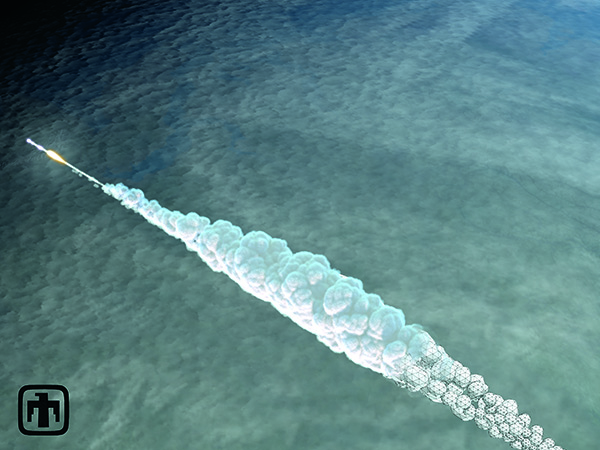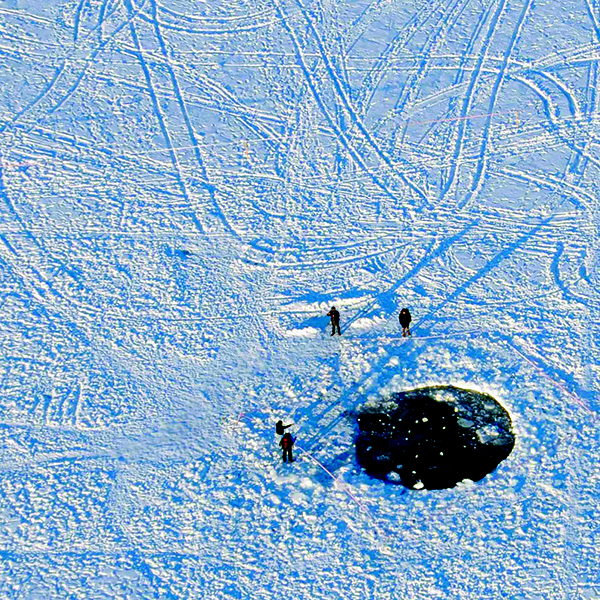
by Harvey Leifert Monday, May 12, 2014

A 3-D simulation of the Chelyabinsk airburst. Credit: Andrea Carvey, Mark Boslough & Brad Carvey
At about 9:20 a.m. on Feb. 15, 2013, many of those cameras recorded the explosion of a large meteor 23 kilometers above the city. As was widely reported at the time, the air blast shattered windows, and meteorite fragments rained down in and around Chelyabinsk, causing damage to some 7,000 buildings and sending about 1,600 people to hospitals. Although no one was killed, it marks “the first ever asteroid impact disaster in human history,” according to Clark R. Chapman of the Southwest Research Institute (SwRI) Planetary Science Directorate in Boulder, Colo., who presented research on the event at the annual meeting of the American Geophysical Union (AGU) in San, Francisco, Calif., last December.
In the year since the explosion, researchers have closely analyzed those dashboard videos and collected data from other sources, resulting in a wealth of information about what happened that morning and what it may mean for the future. Researchers shared their discoveries and insights at the AGU meeting.
Analysis of the videos showed that the meteor entered the atmosphere at a shallow angle, about 18 degrees from the horizontal. Had its trajectory been more perpendicular to Earth’s surface, Chapman said at a press conference at the AGU meeting, it would have generated a much stronger shockwave and done considerably more damage. So in that sense, he said, the residents of the Chelyabinsk area were lucky.

The main fragment of the Chelyabinsk meteorite impacted Lake Chebarkul. Credit: Eduard Kalinin
But videos were not the only source of information about the meteor burst. Infrasound detectors in nearby Kazakhstan, part of a worldwide network to detect nuclear explosions, recorded the impact, as did seismic stations up to thousands of kilometers away, and both contributed to estimating the size of the meteor, noted Alexandr Smirnoff of the KazNDC Institute of Geophysical Research in Almaty, Kazakhstan, at the press conference.
Other scientists analyzed the meteorite fragments. Microscopic analysis has allowed researchers to trace the formation of the parent body back to within the first 4 million years of solar system history, about 4.56 billion years ago, and to determine how it formed, noted David A. Kring of USRA-Lunar and Planetary Institute in Houston, Texas, at the AGU press conference. Over a period of about 10 million years, material accreted until it was an asteroid on the order of 100 kilometers in diameter, with the eventual Chelyabinsk meteor buried within it, Kring said.
About 125 million years after formation, the parent body suffered a major impact event. Then there was a dearth of impacts for 2 billion years, followed by one or two during the past 500 million years, one of them about 25 million to 30 million years ago. The asteroid’s orbit then shifted from the main asteroid belt between Mars and Jupiter to a near-Earth orbit, Kring said. Just 1.2 million years ago, it experienced another impact or other fragmenting event, which sent it on its final trajectory to Chelyabinsk.
The recent impact event shattered our illusions of safety. Before 2013, NASA had estimated that a meteor of about 40 meters diameter or less would burst harmlessly in Earth’s upper atmosphere and would thus pose little to no threat to humans. But calculations based on filmed trajectories and other data put the Chelyabinsk meteor at about 20 meters — 10 times less massive — Chapman said.
The lesson from Chelyabinsk is not only that a relatively small near-Earth object (NEO) can do significant damage, but that NEOs may be more numerous (and their impacts with Earth more frequent) than previously estimated, he said. Astronomers had thought that a Chelyabinsk-sized burst was a once-in-200-years event, but now an emerging consensus holds that events of this type can occur more frequently. “In our lifetimes, there will probably be more of these Chelyabinsks, and so, we ought to get used to them,” he added.
improve our ability to detect NEOs in time, Chapman said, adding that two programs in development will assist in that effort. The Sentinel spacecraft, privately funded and scheduled for launch in 2018, will have an orbit similar to that of Venus and search for NEOs, although mainly those larger than the Chelyabinsk meteor. It is expected to provide years or decades of warning of the possibility and location of an Earth impact, and could provide sufficient advance notice to organize a deflection mission.
The second project, funded by NASA, is the Asteroid Terrestrial-Impact Last Alert System (ATLAS) at the University of Hawaii. Costing just a few million dollars a year, it involves two small telescopes that will survey the sky nightly, looking for points of light of faint magnitude that grow successively brighter, suggesting an asteroid approaching Earth. This scenario actually occurred several years ago, Boslough said, when a telescope serendipitously recorded an approaching object. Scientists calculated that it would impact Sudan in 19 hours, which it did, just a few kilometers from the predicted point.
The fragmented “mother ship” of the Chelyabinsk meteor still exists, Kring said. And some of the fragments are Chelyabinsk-sized or larger. “There are a lot of Chelyabinsk meteors out there in space, and some of those are going to hit Earth in the future.”
© 2008-2021. All rights reserved. Any copying, redistribution or retransmission of any of the contents of this service without the expressed written permission of the American Geosciences Institute is expressly prohibited. Click here for all copyright requests.